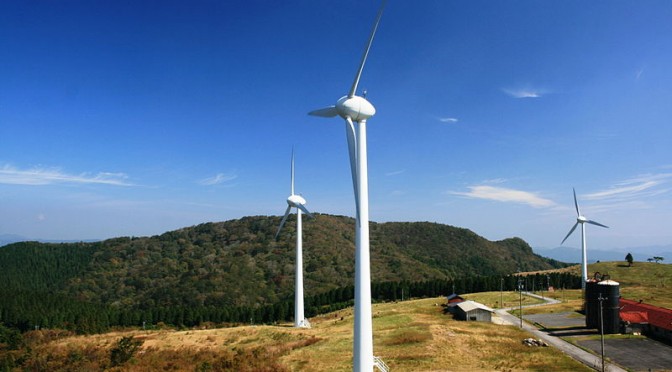The government aims to triple the nation’s supply capacity of electricity generated through wind power to 7.5 million kilowatts by developing transmission grids in Hokkaido and the Tohoku region, it has been learned.
Under a decadelong project the government will launch in fiscal 2013, which starts in April, the public and private sectors will spend about 310 billion yen on development.
Wind is considered a key source for increasing the proportion of renewable energy because it can generate a great deal of power at one site and is less expensive than solar and geothermal energy.
The government estimates that wind power generation cost just about 10 yen per kilowatt hour as of 2010–almost the same as thermal power generation by liquefied natural gas.
However, wind-generated power in Japan amounted to 179.63 million kilowatt-hours in fiscal 2011–less than 0.1 percent of the nation’s total power production.
The government hopes that building transmission grids to increase the supply capacity of electricity generated by wind power will help achieve a desirable balance within the energy supply.
Given the strong winds that regularly blow there, Hokkaido and the coastlines of Tohoku are among the most suitable locations in the nation for wind power generation. Currently, Hokkaido Electric Power Co. and Tohoku Electric Power Co. have built transmission lines to connect wind power generation sites and existing transmission networks.
However, the two utilities have found it difficult to further promote wind power generation due to difficulties securing funds to build more transmission lines.
For the envisaged project, the government has decided to cover the costs of building transmission grids with fees for using the networks collected from wind power generating companies. The companies will be set up mainly by trading houses.
The areas to be designated by the government for promoting wind power generation will be northern Hokkaido, the Shimokita and Tsugaru peninsulas in Aomori Prefecture, and the Akita Prefecture coast.
In each area, power firms and wind power generating companies will establish special-purpose companies that will be in charge of building transmission grids. Half the costs of building the facilities will be covered by subsidies from the central government.
Wind-generated power in Hokkaido and Tohoku would also likely be sent to the Tokyo metropolitan area and other locations via the transmission networks of major utility firms.
In addition to Hokkaido and Tohoku, an increasing amount of power has been generated by wind in other areas, such as the Hokuriku and Sanin regions and Kyushu. If the envisaged method to cover the costs of building transmission grids with fees for using the networks is also applied in these areas, the government estimates the nation could increase the capacity of wind-generated power to 14.7 million kilowatts, about six times today’s level.
Unlike nuclear reactors or thermal power generators, however, it is difficult for wind power generators to maintain maximum output because the strength of the wind is constantly changing. Therefore, transformer substations should be equipped with large-scale reserve cells to achieve a stable supply of wind-generated power.
Other issues related to wind power generation include the fact that it usually takes about seven years from creating a plan and assessing the environmental impact to finally starting operations for commercial use. Wind-power generation also often causes noise and other kinds of environmental problems.
Under the envisaged project, the government also will establish research themes for each designated area to develop technologies to achieve a stable supply of wind-generated power.




